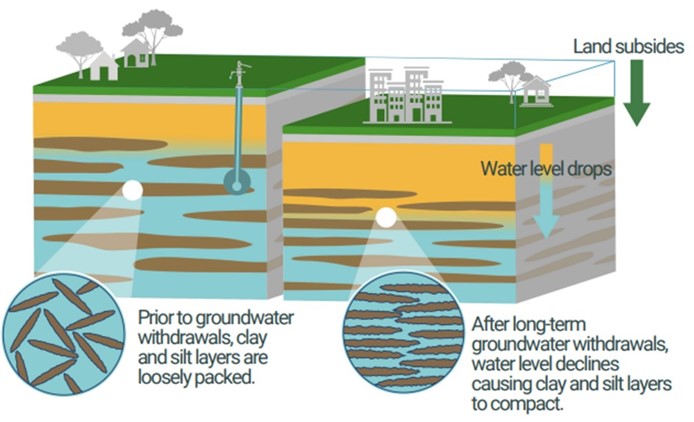Subsidence
Subsidence is the sinking of the land surface due to changes in the soil or sediment beneath our feet. Subsidence occurs for a variety of reasons such as groundwater pumping, oil extraction, and geologic processes. Subsidence is a slow process and is usually measured in inches per year, but over time these small changes can add up to many feet and create significant problems for infrastructure and communities.

Subsidence due to groundwater pumping occurs when the water pressure in the subsurface sediment is reduced and the fine-grained sediment (such as silt and clay) compacts. As the water pressure is reduced by pumping, the fine-grained soil particles reorganize and compress into a flatter structure. This subsurface compaction results in the lowering of the land surface and, depending on the type of sediments, this change may not be reversible. Subsidence due to groundwater pumping is effectively minimized only when groundwater levels are allowed to rise as rapidly and as much as possible above historical levels where subsidence is known to occur.
Educational Resources
The resources below are provided to assist local Sustainable Groundwater Management Act (SGMA) implementation efforts. The resources are tailored for use in educating the public on various aspects of subsidence. While the resources may not be applicable to all GSAs, they are meant to engage audiences and communicate complex information. More resources and helpful links will be added to this section soon as DWR rolls out additional material on subsidence.
Subsidence 101 Video
You may have heard of the term subsidence, but what does it mean? Subsidence is the sinking of land which can be caused by various factors including groundwater pumping. In California, subsidence has been documented for over a century and is a growing issue that impacts our water infrastructure and the communities who rely on it.
Subsidence 101 Factsheet
Subsidence 101 Factsheet – This informational flyer explains the basics of subsidence and the history of subsidence in California and introduces the impacts of subsidence on different infrastructure types.
Impacts of Land Subsidence Factsheet
Impacts of Land Subsidence Factsheet – This factsheet provides a deeper dive on the significant impacts subsidence can have on infrastructure and communities.
The Role of Critical Head in Managing Land Subsidence
This video presents the science and mechanics of subsidence. It explains the principle of effective stress in soils, introduces the concept of critical head, and explains how subsidence can be managed using critical head. The second part of the video covers examples of how to calculate critical head based on examples in the San Joaquin Valley.
NEW: On July 24, 2025, the Department of Water Resources released a Draft Best Management Practices on managing Land Subsidence in California. To review the draft document and find information on how to provide public comments and attend public meetings, see the Best Management Practices and Guidance Documents webpage.
